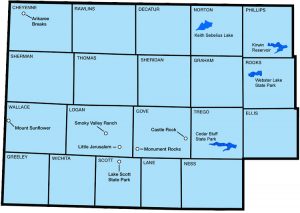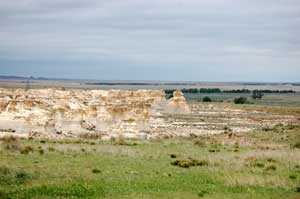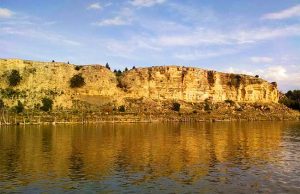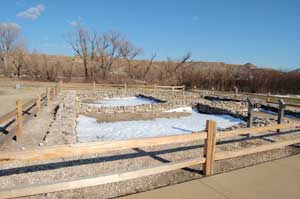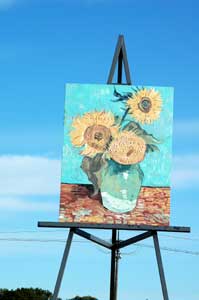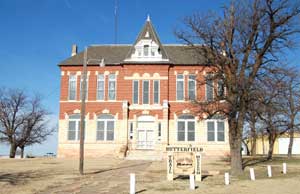Northwest Kansas, dominated by the High Plains and Smoky Hills geographic regions, includes some of the most stunning landscapes in the state. Explore the rugged canyons of the Arikaree Breaks; discover the towering chalk formations of Castle Rock and Monument Rocks; hiking and water recreation can be found at Lake Scott and Cedar Bluff State Parks, and visit the highest point in the state at Mount Sunflower. On the short-grass prairies, there are beautiful views of wildflowers and wildlife in an area known for its hunting opportunities for deer, turkey, and pheasants.
The Northwest region encompasses the area from the Colorado border on the east, near Weskan, north to the Nebraska border, west to Agra, and then south to Hays.
Three scenic byways are included in the northwest region:
Smoky Valley Scenic Byway – Whether you prefer enjoying the natural beauty of wildflowers, the picturesque vista of windmills, or the beauty of limestone bluffs, the Smoky Valley Scenic Byway will provide you with a beautiful glimpse of western Kansas. The byway travels an out-and-back route from WaKeeney on Interstate 70, south to Ransom on US 283, east to Brownell on K-4, and then north past Cedar Bluff Reservoir on K-147.
Western Vistas Historic Byway – Traveling along Highway 40 is a perfect opportunity to discover the rich history and scenic beauty of Kansas’ first historic byway. The byway spans three western Kansas counties, covering a distance of 102 miles. It features six museums plus 12 historic and scenic sites. The byway runs north from Scott City to Oakley (US 83), then west to Sharon Springs (US 40), and can be traveled in either direction, with numerous stops between these cities. Along this route are side trips, including Lake Scott State Park (Hwy 95) and Russell Springs (Hwy 25).
Land and Sky Scenic Byway – Travelers along this byway in western Kansas can experience the Wallace Branch of the Great Western Cattle Trail, scale the highest point in Kansas at Mount Sunflower, and explore the deep canyons and rugged landscape of the Arikaree Breaks. The byway is also the only one in the state focusing on agriculture and features thousands of acres of rotating crops, livestock, and wildlife along the route. The byway traverses Kansas Highway 27 from the Nebraska border near St. Francis, south through Goodland, and to Sharon Springs.
More great sites to see in Northwest Kansas include:
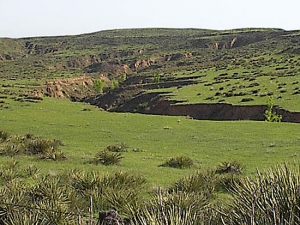
Arikaree Breaks in Cheyenne County, Kansas, courtesy of Natural Kansas.
Arikaree Breaks – “The Breaks” is a scenic badland area on the extreme northern edge of Cheyenne County. This area of extremely rough terrain, with its deep ravines and gullies, presents a marked contrast to the plains typically associated with the region. The Breaks are 36 miles long and two to three miles wide, offering scenic beauty that makes the trip worthwhile. The St. Francis Chamber of Commerce has a driving tour of the area.
Decatur County:
Last Indian Raid Museum – The museum comprises 14 buildings and a vast collection of Indian artifacts. Buildings include a 1922 schoolhouse, a doctor’s office, an old Phillips service station, a sod house, a general store, and others. Located at 258 S. Penn in Oberlin, Kansas.
Bukovina Society Headquarters and Museum – This is a museum of artifacts from Bukovina, including those of German immigrants who settled in Ellis in 1886. It is in a historic church building at 718 Washington in Ellis, Kansas.
Ellis County Historical Society Museum – Features area history from the Wild West through World War II, including a saloon, 1879 stone chapel, early 1900s harness shop, and Volga German Haus. 100 W. 7th, Hays, Kansas 67601, 785-628-2624
Fort Hays State Historic Site – Fort Hays was established in 1867 to protect the construction workers building the Union Pacific Railroad. The original blockhouse, guardhouse, and officer quarters are located here and exhibit interpretive displays of pioneer, military, and “Wild West” history. This frontier fort once housed frontier names such as General George Armstrong Custer, William F. “Buffalo Bill Cody, and James B. “Wild Bill” Hickok. Admission fee. 1272 Alternate Hwy 183, Hays, Kansas 67601, 785-625-6812.
Hays City Walking Tour – Brochures are available at the Ellis County Historical Society Museum, 100 W. 7th, Hays, Kansas 785-628-2624.
Sternberg Museum of Natural History – Extensive fossil collection and animated, life-size dinosaurs. The changing exhibit gallery features world-class traveling exhibits on natural history. It is at 3000 Sternberg Drive, Hays, Kansas 67601, 785-628-4286.
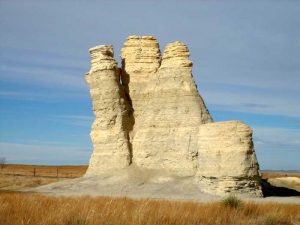
Castle Rock is located in Gove County, Kansas, according to Wikipedia.
Gove County:
Castle Rock – This chalk pinnacle rises from the prairie 20 miles southeast of Quinter. The area is a paradise for fossil hunters. Monument Rocks and Castle Rock were selected as one of the 8 Wonders of Kansas. If you travel to these ancient rock formations, please remember that you are on private property and treat the formations with respect.
Monument Rocks – Rising majestically from the seemingly flat prairie, just 25 miles south of Oakley, are the Monument Rocks, Kansas’s first national natural landmark. These wind-carved, water-eroded chalk formations are the sedimentary remains of ancient marine life, dating back up to 200 million years.
Graham County:
Nicodemus National Historic Site – In July 1877, African American “Exodusters” from Kentucky established a settlement in the Promised Land of Kansas, known as Nicodemus. Although the colonists lacked sufficient tools, seeds, and money, they survived the first winter, some by selling buffalo bones, while others worked for the Kansas Pacific Railroad at Ellis, 35 miles away. In 1880, the all-Negro community had a population of more than 400. On November 12, 1996, Nicodemus, located in eastern Graham County, became a National Historic Site.
Oil Patch Museum – Located on the west side of Hill City, this museum shows some of the machinery used to make the Graham County area a leading oil producer. It is located at 800 W Highway 24.
Buffalo Bill Cultural Center & Buffalo Bill Sculpture – The Buffalo Bill Cultural Center is a Kansas community partner Travel Information Center. In front of the center is a Buffalo Bill Bronze Sculpture that is literally “larger than life.” The sculpture is located at the intersection of West 2nd Street and US 83 Highway in Oakley, Kansas.
Butterfield Trail Museum – Housed in the historic Logan County courthouse, the museum showcases artifacts related to the Butterfield Trail’s history. It features fossils from the Cretaceous Period that are abundant in this area of Kansas. The museum is located off of K-25 in Russell Springs, Kansas.
Fick Fossil and History Museum – The collection of fossils is entirely genuine, with no reproductions. They were collected mainly from the Monument Rocks region of Logan, Scott, Gove, and Lane counties in Kansas. The collection does include dinosaurs. The museum also features historic exhibits, including a replica of the 1886 Oakley Depot, the Prather Creamery, the General Store, and a military room. It is located at 700 West 3rd Street in Oakley, Kansas.
Little Jerusalem Badlands – This 332-acre area encompasses 220 acres of dramatic chalk rock formations from when an inland sea covered Kansas. These fragile yet ruggedly spectacular geologic formations offer breathtaking views. They are home to a diverse array of wildlife, including bats, ferruginous hawks, snakes, toads, lizards, and plants found nowhere else in the world. The park features a mile-long stretch of 100-foot-tall spires and cliffs, located between Oakley and Historic Lake Scott State Park.
Smoky Valley Ranch – This 19,000-acre Nature Conservancy invites visitors year-round to enjoy its hiking and horseback trails that provide views of prairie vistas and chalk bluffs. Overlooking the Smoky Hill River, the ranch also provides glimpses of wildlife, including prairie chickens, pronghorn, mule and white-tail deer, ferruginous hawks, burrowing owls, golden eagles, and swift foxes. It is located at 1114 County Road 370, about 25 miles southwest of Oakley, Kansas.
Norton County:
Keith Sebelius Lake – Formerly known as Norton Reservoir, is a man-made reservoir on Prairie Dog Creek in northwest Kansas. Built and managed by the US Bureau of Reclamation, it is used for flood control, irrigation, recreation, and local water supply. Prairie Dog State Park is located on its shore. The lake includes boat ramps, camping facilities, a hiking trail, and a swimming beach. It is also open for sport fishing year-round, and hunting is permitted on the public land around the reservoir, although it is restricted in certain areas.
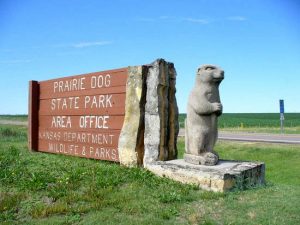
Prairie Dog State Park, Norton, Kansas, courtesy of of Trip Advisor.
Prairie Dog State Park – The park occupies 1,150 acres on the shores of Keith Sebelius Reservoir. Prairie Dog State Park is home to a thriving prairie dog colony and is the site of the last remaining adobe house in Kansas. The renovated adobe house was built on the site in the early 1890s. Sebelius Reservoir is renowned for its excellent fishing opportunities for black bass, walleye, wiper, crappie, catfish, and saugeye. Prairie Dog State Park is located near Norton, Kansas.
Station 15 – Located in Norton, Kansas, this replica of an early stagecoach station features period furnishings. It sits in a roadside park beside Highway 36 at 537 Wilmington Street. Buffalo Bill, Billy the Kid, and Horace Greeley passed through this stage depot.
Phillips County:
Fort Bissell – In the spring of 1873, the Army sent word from Fort Hays that an attack by Apache Indians was imminent. Phillipsburg’s Fort Bissell was hastily built, but it was never needed. Old Fort Bissell, now located in a Phillipsburg Park, offers a visit to a frontier community.
Dane G. Hansen Museum – This Museum in Logan hosts annual exhibits from around the country, including those from the Smithsonian Institution. The Museum is recognized as one of the best in Kansas.

Kirwin Reservoir, Kansas.
Kirwin Reservoir & National Wildlife Refuge – This reservoir, located adjacent to the city of Kirwin, was constructed by the US Bureau of Reclamation for flood control and irrigation in the area. The Kirwin National Wildlife Refuge lies on its shores.
Lake Atwood – A lighted walking path with a unique walking bridge encircles this beautiful 43-acre lake at the north end of Atwood. Magnificent old cottonwood trees, shaded campsites, and picnic areas surround the Lake. The Hayden Nature Trail, a natural wildlife habitat, is located in the West Lake area.
Rawlins County Museum – Established in 1967, this museum serves as the headquarters of the Rawlins County Historical Society.
Rooks County:
Webster Reservoir and State Park – The 3,780-acre lake has campgrounds, picnic areas, swimming, volleyball courts, shower houses, shelters, hiking trails, boat ramps, fish cleaning stations, electric hookups, and more. It is located seven miles west of Stockton on Highway 24.
Cedar Bluff State Park – Located just 13 miles south of Interstate 70 in northwest Kansas, Cedar Bluff State Park is situated. The park straddles Cedar Bluff Reservoir, with the Bluffton Area located on the north shore and the Page Creek Area on the south shore. Camping, boating, outdoor sports, wildlife viewing, and other opportunities are available in the park. With a unique look into Kansas’ history, the many activities available at Cedar Bluff make it a quality destination. Cedar Bluff State Park is located in Ellis, Kansas.
Scott County:
Battle of Punished Woman’s Fork – The Battle of Punished Woman’s Fork occurred when Northern Cheyenne Chiefs Dull Knife and Little Wolf led their people from their reservation in Oklahoma back to their former home in the north. On September 27, 1878, pursuing soldiers caught up with them, and a battle occurred. In the skirmish, Commanding Officer Lieutenant Colonel William H. Lewis was mortally wounded. It was the last Indian battle in Kansas, and Lewis was the last officer killed in military action in the state. After the battle, the Northern Cheyenne fled during the night. Designated a State and National historic site, the battle site is located about one mile south of Lake Scott State Park, off Hwy 95. A monument overlooks a cave, a canyon, and the bluffs where the Northern Cheyenne hid, waiting to ambush the US Cavalry.
El Quartelejo Museum – The museum focuses on the history of the Scott County area and features numerous exhibits showcasing fossils. A Pueblo Indian display, early Indian scenes, and a Pioneer homestead offer the historical displays. Located at 902 W. 5th in Scott City, Kansas.
El Cuartelejo Pueblo Ruins – A National Historic Landmark, an archeological dig that has uncovered a pueblo ruin dating from 1650 to 1750 A.D. and is thought to have been constructed by the Taos Indians from New Mexico. Located inside Scott County State Park.
Keystone Gallery – Houses a permanent collection of local Kansas Cretaceous fossils, as well as paintings and scenic photography. 401 US 83, Scott City, Kansas 67871, 620-872-2762. Halfway between Scott City and Oakley.
Scott Lake State Park – The Park is ideal for boating, swimming, hiking, hunting, fishing, and wildlife observation. Scott State Park is a startling oasis of natural springs, deeply wooded canyons, and craggy bluffs. The 1,020-acre park surrounds the 100-acre, spring-fed Scott State Fishing Lake, and nature trails accommodate hikers, horseback riders, and naturalists. The Steele home, the dwelling of the original settlers in the area, has been preserved much as it was 100 years ago. The park also boasts the northernmost pueblo in the U. S. – El Cuartelejo. Scott State Park is located near Scott City, Kansas. The park is located at 520 W. Scott Lake Drive in Scott City, Kansas.
Cottonwood Ranch –Located 15 miles east of Hoxie on Highway 24, this English-style home was once a successful sheep ranch. The Ranch was established in the late 1800s by Fenton Pratt, who emigrated from England. The Kansas Historical Society purchased it in 1982.
Mickey’s Museum – This museum showcases generations of Sheridan County history through household items, clothing, photographs, farming tools, local business artifacts, and more. An authentic one-room schoolhouse also rests on museum grounds. Donated by Vernon Mickey of Hoxie, it is operated by the Sheridan County Historical Society. It is located two blocks east of the Highway 23 and 24 intersection at 1224 Oak Avenue in Hoxie, Kansas. The museum is open to the public by appointment made through the Sheridan County Historical Society office.
Sherman County:
High Plains Museum – Established in 1959, the City of Goodland owns and operates this museum. It features objects from its collection of over 8,000 items, representing more than 100 years of Northwestern Kansas history. In 1979, an addition was added to the building to house a full-sized, automated replica of America’s First Patented Helicopter. The original craft was invented and built by W.J. Purvis and C.A. Wilson of Goodland in 1909. The museum is located at 1717 Cherry Avenue in Goodland, Kansas.
Giant Van Gogh – This giant sunflower painting on the south side of Goodland stands as a testament to Goodland as the “High Plains Sunflower Capital.”
Prairie Museum of Art and History – Visit this cultural center located on the High Plains of Kansas, which spans 24 acres and features six historic structures, including the 1936 Cooper Barn, the Lone Star Presbyterian Church, a well-preserved sod house, a one-room schoolhouse, and the 1930s Eller House. Operated by the Thomas County Historical Society, you will find the County Library and Archives on the property. 1905 S. Franklin, Colby, Kansas 67701.
Trego County Historical Society Museum – Preserves Trego County history in a vast collection of pioneer possessions. Located on the Trego County Fairgrounds on the East edge of WaKeeney on Highway 283, North of the I-70 exit 126.
Wallace County:
Fort Wallace Museum – This museum features several historic structures, including the old Fort Wallace Post Cemetery. Early visitors to Fort Wallace included Wild Bill Hickok, Buffalo Bill, William Comstock, and George Armstrong Custer. View the barbed wire statues in the Sunderland-Poe building and see the oldest building in Western Kansas. The Pond Creek Stagecoach Station was built in 1865 and was part of the Butterfield Overland Dispatch. Located on Highway 40 in Wallace, Kansas.
Mount Sunflower – The highest point in Kansas, Mount Sunflower is located near the Colorado border in Wallace County. The site is open year-round. Please be respectful of personal property.
Museum of the Great Plains – Operated by the Wichita County Historical Society, the museum is located in the old Shallow Water Train Depot. The museum houses artifacts related to the early history of Wichita County, along with the extensive railroad collection of Richard L. George. Located in Leoti, Kansas.
©Kathy Alexander/Legends of Kansas, updated October 2025.
Also See:
Sources:


